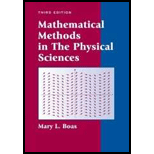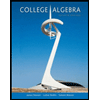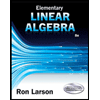
Mathematical Methods in the Physical Sciences
3rd Edition
ISBN: 9780471198260
Author: Mary L. Boas
Publisher: Wiley, John & Sons, Incorporated
expand_more
expand_more
format_list_bulleted
Textbook Question
Chapter 14.6, Problem 20P
Find the residues of the following functions at the indicated points. Try to select the easiest of the methods outlined above. Check your results by computer.
Expert Solution & Answer
Want to see the full answer?
Check out a sample textbook solution
Students have asked these similar questions
Find the residue of the following functions at z0 = 0:
Find the fourth-degree Taylor polynomial T4(x) for the function f(x)=cosx at the number x=π/3.
T4(x)=
Find the residue of the following functions at the indicated poles:
Chapter 14 Solutions
Mathematical Methods in the Physical Sciences
Ch. 14.1 - Find the real and imaginary parts u(x,y) and...Ch. 14.1 - Find the real and imaginary parts u(x,y) and...Ch. 14.1 - Find the real and imaginary parts u(x,y) and...Ch. 14.1 - Find the real and imaginary parts u(x,y) and...Ch. 14.1 - Find the real and imaginary parts u(x,y) and...Ch. 14.1 - Find the real and imaginary parts u(x,y) and...Ch. 14.1 - Find the real and imaginary parts u(x,y) and...Ch. 14.1 - Find the real and imaginary parts u(x,y) and...Ch. 14.1 - Find the real and imaginary parts u(x,y) and...Ch. 14.1 - Find the real and imaginary parts u(x,y) and...
Ch. 14.1 - Find the real and imaginary parts u(x,y) and...Ch. 14.1 - Find the real and imaginary parts u(x,y) and...Ch. 14.1 - Find the real and imaginary parts u(x,y) and...Ch. 14.1 - Find the real and imaginary parts u(x,y) and...Ch. 14.1 - Find the real and imaginary parts u(x,y) and...Ch. 14.1 - Find the real and imaginary parts u(x,y) and...Ch. 14.1 - Find the real and imaginary parts u(x,y) and...Ch. 14.1 - Find the real and imaginary parts u(x,y) and...Ch. 14.1 - Find the real and imaginary parts u(x,y) and...Ch. 14.1 - Find the real and imaginary parts u(x,y) and...Ch. 14.1 - Find the real and imaginary parts u(x,y) and...Ch. 14.2 - 1 to 21. Use the Cauchy-Riemann conditions to find...Ch. 14.2 - 1 to 21. Use the Cauchy-Riemann conditions to find...Ch. 14.2 - 1 to 21. Use the Cauchy-Riemann conditions to find...Ch. 14.2 - 1 to 21. Use the Cauchy-Riemann conditions to find...Ch. 14.2 - 1 to 21. Use the Cauchy-Riemann conditions to find...Ch. 14.2 - 1 to 21. Use the Cauchy-Riemann conditions to find...Ch. 14.2 - 1 to 21. Use the Cauchy-Riemann conditions to find...Ch. 14.2 - 1 to 21 . Use the Cauchy-Riemann conditions to...Ch. 14.2 - 1 to 21. Use the Cauchy-Riemann conditions to find...Ch. 14.2 - 1 to 21. Use the Cauchy-Riemann conditions to find...Ch. 14.2 - 1 to 21. Use the Cauchy-Riemann conditions to find...Ch. 14.2 - 1 to 21. Use the Cauchy-Riemann conditions to find...Ch. 14.2 - 1 to 21. Use the Cauchy-Riemann conditions to find...Ch. 14.2 - 1 to 21. Use the Cauchy-Riemann conditions to find...Ch. 14.2 - 1 to 21. Use the Cauchy-Riemann conditions to find...Ch. 14.2 - 1 to 21. Use the Cauchy-Riemann conditions to find...Ch. 14.2 - 1 to 21. Use the Cauchy-Riemann conditions to find...Ch. 14.2 - 1 to 21. Use the Cauchy-Riemann conditions to find...Ch. 14.2 - 1 to 21. Use the Cauchy-Riemann conditions to find...Ch. 14.2 - 1 to 21. Use the Cauchy-Riemann conditions to find...Ch. 14.2 - 1 to 21. Use the Cauchy-Riemann conditions to find...Ch. 14.2 - 1 to 21. Use the Cauchy-Riemann conditions to find...Ch. 14.2 - 1 to 21. Use the Cauchy-Riemann conditions to find...Ch. 14.2 - 1 to 21. Use the Cauchy-Riemann conditions to find...Ch. 14.2 - Using the definition (2.1) of (d/dz)f(z), show...Ch. 14.2 - Using the definition (2.1) of (d/dz)f(z), show...Ch. 14.2 - Prob. 27PCh. 14.2 - Using the definition (2.1) of (d/dz)f(z), show...Ch. 14.2 - Problem 28 is the chain rule for the derivative of...Ch. 14.2 - Problem 28 is the chain rule for the derivative of...Ch. 14.2 - Problem 28 is the chain rule for the derivative of...Ch. 14.2 - Using the definition of ez by its power series...Ch. 14.2 - Using the definitions of sin...Ch. 14.2 - Using series you know from Chapter 1, write the...Ch. 14.2 - Using series you know from Chapter 1, write the...Ch. 14.2 - Using series you know from Chapter 1, write the...Ch. 14.2 - Using series you know from Chapter 1, write the...Ch. 14.2 - Using series you know from Chapter 1, write the...Ch. 14.2 - Using series you know from Chapter 1, write the...Ch. 14.2 - Using series you know from Chapter 1, write the...Ch. 14.2 - Using series you know from Chapter 1, write the...Ch. 14.2 - Using series you know from Chapter 1, write the...Ch. 14.2 - In Chapter 12, equations (5.1) and (5.2), we...Ch. 14.2 - Prob. 44PCh. 14.2 - Prob. 45PCh. 14.2 - Prob. 46PCh. 14.2 - Prob. 47PCh. 14.2 - Using polar coordinates (Problem 46), find out...Ch. 14.2 - Prob. 49PCh. 14.2 - Using polar coordinates (Problem 46), find out...Ch. 14.2 - Prob. 51PCh. 14.2 - Prob. 52PCh. 14.2 - Using polar coordinates (Problem 46), find out...Ch. 14.2 - Show that the following functions are harmonic,...Ch. 14.2 - Show that the following functions are harmonic,...Ch. 14.2 - Show that the following functions are harmonic,...Ch. 14.2 - Show that the following functions are harmonic,...Ch. 14.2 - Show that the following functions are harmonic,...Ch. 14.2 - Show that the following functions are harmonic,...Ch. 14.2 - Show that the following functions are harmonic,...Ch. 14.2 - Show that the following functions are harmonic,...Ch. 14.2 - Show that the following functions are harmonic,...Ch. 14.2 - Show that the following functions are harmonic,...Ch. 14.2 - It can be shown that, if u(x,y) is a harmonic...Ch. 14.3 - Evaluate the following line integrals in the...Ch. 14.3 - Evaluate the following line integrals in the...Ch. 14.3 - Evaluate the following line integrals in the...Ch. 14.3 - Evaluate the following line integrals in the...Ch. 14.3 - Evaluate the following line integrals in the...Ch. 14.3 - Evaluate the following line integrals in the...Ch. 14.3 - Evaluate the following line integrals in the...Ch. 14.3 - Evaluate the following line integrals in the...Ch. 14.3 - Evaluate the following line integrals in the...Ch. 14.3 - Evaluate the following line integrals in the...Ch. 14.3 - Evaluate C(z3)dz where C is the indicated closed...Ch. 14.3 - 01+2iz2dz along the indicated paths:Ch. 14.3 - In Chapter 6, Section 11, we showed that a...Ch. 14.3 - In finding complex Fourier series in Chapter 7, we...Ch. 14.3 - If f(z) is analytic on and inside the circle z=1,...Ch. 14.3 - If f(z) is analytic in the disk z2, evaluate...Ch. 14.3 - Use Cauchys theorem or integral formula to...Ch. 14.3 - Use Cauchys theorem or integral formula to...Ch. 14.3 - Use Cauchys theorem or integral formula to...Ch. 14.3 - Use Cauchys theorem or integral formula to...Ch. 14.3 - Differentiate Cauchys formula (3.9) or (3.10) to...Ch. 14.3 - Use Problem 21 to evaluate the following...Ch. 14.3 - Use Problem 21 to evaluate the following...Ch. 14.3 - Use Problem 21 to evaluate the following...Ch. 14.4 - Show that the sum of a power series which...Ch. 14.4 - Show that equation ( 4.4 ) can be written as...Ch. 14.4 - For each of the following functions find the first...Ch. 14.4 - For each of the following functions find the first...Ch. 14.4 - For each of the following functions find the first...Ch. 14.4 - For each of the following functions find the first...Ch. 14.4 - For each of the following functions find the first...Ch. 14.4 - For each of the following functions find the first...Ch. 14.4 - For each of the following functions, say whether...Ch. 14.4 - For each of the following functions, say whether...Ch. 14.4 - For each of the following functions, say whether...Ch. 14.4 - For each of the following functions, say whether...Ch. 14.5 - If C is a circle of radius about z0, show that...Ch. 14.5 - Verify the formulas (4.3) for the coefficients in...Ch. 14.5 - Obtain Cauchys integral formula ( 3.9 ) from the...Ch. 14.6 - Find the Laurent series for the following...Ch. 14.6 - Find the Laurent series for the following...Ch. 14.6 - Find the Laurent series for the following...Ch. 14.6 - Find the Laurent series for the following...Ch. 14.6 - Find the Laurent series for the following...Ch. 14.6 - Find the Laurent series for the following...Ch. 14.6 - Find the Laurent series for the following...Ch. 14.6 - Find the Laurent series for the following...Ch. 14.6 - Find the Laurent series for the following...Ch. 14.6 - Show that rule B is correct by applying it to...Ch. 14.6 - Derive (6.2) by using the limit definition of the...Ch. 14.6 - Prove rule C for finding the residue at a multiple...Ch. 14.6 - Prove rule C by using (3.9). Hints: If f(z) has a...Ch. 14.6 - Find the residues of the following functions at...Ch. 14.6 - Find the residues of the following functions at...Ch. 14.6 - Find the residues of the following functions at...Ch. 14.6 - Find the residues of the following functions at...Ch. 14.6 - Find the residues of the following functions at...Ch. 14.6 - Find the residues of the following functions at...Ch. 14.6 - Find the residues of the following functions at...Ch. 14.6 - Find the residues of the following functions at...Ch. 14.6 - Find the residues of the following functions at...Ch. 14.6 - Find the residues of the following functions at...Ch. 14.6 - Find the residues of the following functions at...Ch. 14.6 - Find the residues of the following functions at...Ch. 14.6 - Find the residues of the following functions at...Ch. 14.6 - Find the residues of the following functions at...Ch. 14.6 - Find the residues of the following functions at...Ch. 14.6 - Find the residues of the following functions at...Ch. 14.6 - Find the residues of the following functions at...Ch. 14.6 - Find the residues of the following functions at...Ch. 14.6 - Find the residues of the following functions at...Ch. 14.6 - Prob. 33PCh. 14.6 - Find the residues of the following functions at...Ch. 14.6 - Find the residues of the following functions at...Ch. 14.6 - For complex z,Jp(z) can be defined by the series...Ch. 14.6 - The gamma function (z) is analytic except for...Ch. 14.7 - The values of the following integrals are known...Ch. 14.7 - The values of the following integrals are known...Ch. 14.7 - The values of the following integrals are known...Ch. 14.7 - The values of the following integrals are known...Ch. 14.7 - The values of the following integrals are known...Ch. 14.7 - The values of the following integrals are known...Ch. 14.7 - The values of the following integrals are known...Ch. 14.7 - The values of the following integrals are known...Ch. 14.7 - The values of the following integrals are known...Ch. 14.7 - The values of the following integrals are known...Ch. 14.7 - The values of the following integrals are known...Ch. 14.7 - The values of the following integrals are known...Ch. 14.7 - The values of the following integrals are known...Ch. 14.7 - The values of the following integrals are known...Ch. 14.7 - The values of the following integrals are known...Ch. 14.7 - The values of the following integrals are known...Ch. 14.7 - The values of the following integrals are known...Ch. 14.7 - The values of the following integrals are known...Ch. 14.7 - The values of the following integrals are known...Ch. 14.7 - The values of the following integrals are known...Ch. 14.7 - In Example 4 we stated a rule for evaluating a...Ch. 14.7 - Using the rule of Example 4 (also see problem 21),...Ch. 14.7 - Using the rule of Example 4 (also see problem 21),...Ch. 14.7 - Using the rule of Example 4 (also see problem 21),...Ch. 14.7 - Using the rule of Example 4 (also see problem 21),...Ch. 14.7 - Using the rule of Example 4 (also see problem 21),...Ch. 14.7 - Using the rule of Example 4 (also see problem 21),...Ch. 14.7 - Using the rule of Example 4 (also see problem 21),...Ch. 14.7 - Using the rule of Example 4 (also see problem 21),...Ch. 14.7 - (a) By the method of Example 2 evaluate 0dx1+x4....Ch. 14.7 - Use the method of Problem 30(c) to evaluate...Ch. 14.7 - Use the method of Problem 30(c) and the contour...Ch. 14.7 - Evaluate the following integrals by the method of...Ch. 14.7 - Evaluate the following integrals by the method of...Ch. 14.7 - Evaluate the following integrals by the method of...Ch. 14.7 - Evaluate the following integrals by the method of...Ch. 14.7 - (a) Show that epx1+exdx=sinp for 0p1. Hint: Find...Ch. 14.7 - Using the same contour and method as in Problem...Ch. 14.7 - Evaluate e2x/3coshxdx. Hint: Use a rectangle as in...Ch. 14.7 - Evaluate 0xdxsinhx. Hint: First find the to ...Ch. 14.7 - The Fresnel integrals, 0usinu2du and 0ucosu2du,...Ch. 14.7 - If F(z)=f(z)/f(z) (a) show that the residue of...Ch. 14.7 - By using theorem (7.8), show that z3+z2+9=0 has...Ch. 14.7 - The fundamental theorem of algebra says that every...Ch. 14.7 - As in Problem 43 find out in which quadrants the...Ch. 14.7 - As in Problem 43 find out in which quadrants the...Ch. 14.7 - As in Problem 43 find out in which quadrants the...Ch. 14.7 - As in Problem 43 find out in which quadrants the...Ch. 14.7 - As in Problem 43 find out in which quadrants the...Ch. 14.7 - As in Problem 43 find out in which quadrants the...Ch. 14.7 - Use (7.8) to evaluate...Ch. 14.7 - Use (7.8) to evaluate z3dz1+2z4 around z=1.Ch. 14.7 - Use (7.8) to evaluate z3+4zz4+8z2+16dz around the...Ch. 14.7 - Use (7.8) to evaluate Csec2(z/4)dz1tan(z/4), where...Ch. 14.7 - Find the inverse Laplace transform of the...Ch. 14.7 - Find the inverse Laplace transform of the...Ch. 14.7 - Find the inverse Laplace transform of the...Ch. 14.7 - Find the inverse Laplace transform of the...Ch. 14.7 - Find the inverse Laplace transform of the...Ch. 14.7 - Find the inverse Laplace transform of the...Ch. 14.7 - Find the inverse Laplace transform of the...Ch. 14.7 - Find the inverse Laplace transform of the...Ch. 14.7 - Find the inverse Laplace transform of the...Ch. 14.7 - Find the inverse Laplace transform of the...Ch. 14.7 - Find the inverse Laplace transform of the...Ch. 14.7 - In equation (7.18), let u(x) be an even function...Ch. 14.8 - Let f(z) be expanded in the Laurent series that is...Ch. 14.8 - (a) Show that if f(z) tends to a finite limit as z...Ch. 14.8 - Find out whether infinity is a regular point, an...Ch. 14.8 - Find out whether infinity is a regular point, an...Ch. 14.8 - Find out whether infinity is a regular point, an...Ch. 14.8 - Find out whether infinity is a regular point, an...Ch. 14.8 - Find out whether infinity is a regular point, an...Ch. 14.8 - Find out whether infinity is a regular point, an...Ch. 14.8 - Find out whether infinity is a regular point, an...Ch. 14.8 - Find out whether infinity is a regular point, an...Ch. 14.8 - Find out whether infinity is a regular point, an...Ch. 14.8 - Find out whether infinity is a regular point, an...Ch. 14.8 - Prob. 13PCh. 14.8 - Evaluate the following integrals by computing...Ch. 14.8 - Evaluate the following integrals by computing...Ch. 14.8 - Observe that in Problems 14 and 15 the sum of the...Ch. 14.9 - In these problems you should be able to make rough...Ch. 14.9 - For each of the following functions w=f(z)=u+iv,...Ch. 14.9 - For each of the following functions w=f(z)=u+iv,...Ch. 14.9 - For each of the following functions w=f(z)=u+iv,...Ch. 14.9 - For each of the following functions w=f(z)=u+iv,...Ch. 14.9 - For each of the following functions w=f(z)=u+iv,...Ch. 14.9 - For each of the following functions w=f(z)=u+iv,...Ch. 14.9 - For each of the following functions w=f(z)=u+iv,...Ch. 14.9 - Describe the Riemann surface for w=z3Ch. 14.9 - Describe the Riemann surface for w=zCh. 14.9 - Describe the Riemann surface for w=lnzCh. 14.9 - If w=f(z)=u(x,y)+iv(x,y),f(z) analytic, defines a...Ch. 14.9 - Verify the matrix equation dudv=Jdxdy, where J is...Ch. 14.9 - We have discussed the fact that a conformal...Ch. 14.9 - Compare the directional derivative...Ch. 14.10 - Prove the theorem stated just after (10.2) as...Ch. 14.10 - Assuming from electricity the equations...Ch. 14.10 - A fluid flow is called irrotational if V=0 where...Ch. 14.10 - Let a flat plate in the shape of a quarter-circle,...Ch. 14.10 - Consider a capacitor made of two very large...Ch. 14.10 - Prob. 6PCh. 14.10 - Use the mapping function w=z2 to find the...Ch. 14.10 - Prob. 8PCh. 14.10 - Find and sketch the streamlines for the flow of...Ch. 14.10 - Find and sketch the streamlines for the indicated...Ch. 14.10 - For w=ln[(z+1)/(z1)], show that the images of u=...Ch. 14.10 - Use the results of Problem 11 to solve the...Ch. 14.10 - Let the figure in Problem 12 represent (the cross...Ch. 14.10 - In the figure in Problem 12, let z=1 be a source...Ch. 14.10 - In Problem 14, the streamlines were the images of...Ch. 14.10 - Two long parallel cylinders form a capacitor. (Let...Ch. 14.11 - In Problems 1 and 2, verify that the given...Ch. 14.11 - In Problems 1 and 2, verify that the given...Ch. 14.11 - Liouvilles theorem: Suppose f(z) is analytic for...Ch. 14.11 - Use Liouvilles theorem (Problem 3 ) to prove the...Ch. 14.11 - In Problems 5 to 8, find the residues of the given...Ch. 14.11 - In Problems 5 to $8,$ find the residues of the...Ch. 14.11 - In Problems 5 to 8, find the residues of the given...Ch. 14.11 - In Problems 5 to $8,$ find the residues of the...Ch. 14.11 - In Problems 9 to 10, use Laurent series to find...Ch. 14.11 - In Problems 9 to $10,$ use Laurent series to find...Ch. 14.11 - Find the Laurent series of f(z)=ez/(1z) for z1 and...Ch. 14.11 - Let f(z) be the branch of z21 which is positive...Ch. 14.11 - In Problems 13 and $14,$ find the residues at the...Ch. 14.11 - In Problems 13 and 14, find the residues at the...Ch. 14.11 - In Problem 15 to 20, evaluate the integrals by...Ch. 14.11 - In Problem 15 to 20, evaluate the integrals by...Ch. 14.11 - In Problem 15 to 20, evaluate the integrals by...Ch. 14.11 - In Problem 15 to $20,$ evaluate the integrals by...Ch. 14.11 - In Problem 15 to 20, evaluate the integrals by...Ch. 14.11 - In Problem 15 to $20,$ evaluate the integrals by...Ch. 14.11 - Verify the formulas in Problem 21 to 27 by contour...Ch. 14.11 - Verify the formulas in Problem 21 to 27 by contour...Ch. 14.11 - Verify the formulas in Problem 21 to 27 by contour...Ch. 14.11 - Verify the formulas in Problem 21 to 27 by contour...Ch. 14.11 - Verify the formulas in Problem 21 to 27 by contour...Ch. 14.11 - Verify the formulas in Problem 21 to 27 by contour...Ch. 14.11 - Verify the formulas in Problem 21 to 27 by contour...Ch. 14.11 - Evaluate 0xlnxdx(1+x)2 by using the contour of...Ch. 14.11 - Evaluate 0(lnx)21+x2dx by using the contour of...Ch. 14.11 - Show that PV0cos(lnx)x2+1dx=2cosh(/2) by...Ch. 14.11 - As in Section 7, find out how many roots the...Ch. 14.11 - As in Section 7, find out how many roots the...Ch. 14.11 - As in Section 7, find out how many roots the...Ch. 14.11 - As in Section 7, find out how many roots the...Ch. 14.11 - Show that the Cauchy-Riemann equations [see (2.2)...Ch. 14.11 - Show that a harmonic function u(x,y) is equal at...Ch. 14.11 - A (nonconstant) harmonic function takes its...Ch. 14.11 - Show that a Dirichlet problem (see Chapter 13,...Ch. 14.11 - Use the following sequence of mappings to find the...Ch. 14.11 - Use L13 of the Laplace transform table to find the...Ch. 14.11 - Evaluate by contour integration 0cos2(/2)122d....
Additional Math Textbook Solutions
Find more solutions based on key concepts
Answer the following regarding the English alphabet. a. Determine the ratio of vowels to consonants. b. What is...
A Problem Solving Approach To Mathematics For Elementary School Teachers (13th Edition)
Repeat problem R2-12 if L=150 mH and L1=L2+400 mH.
Introductory Mathematics for Engineering Applications
Solve each problem involving proportions. Price of Gasoline If 6 gallons of premium unleaded gasoline cost $17....
Mathematical Ideas (13th Edition) - Standalone book
Consider a tank used in certain hydrodynamic experiments. After one experiment the tank contains litter of a d...
Differential Equations: An Introduction to Modern Methods and Applications
49-52: Percentage Comparisons. Complete the following sentences.
49. The life expectancy (at birth) of America...
Using & Understanding Mathematics: A Quantitative Reasoning Approach (7th Edition)
Knowledge Booster
Learn more about
Need a deep-dive on the concept behind this application? Look no further. Learn more about this topic, subject and related others by exploring similar questions and additional content below.Similar questions
- The finance department of a car company conducted a study of their weekly sales in the past years, and came out with the following approximating function : s(t) = 12.18 cos(0.88t - 7.25) + 20.40,t ≥ 0, Where s(t) represents weekly car sales in million pesos at week t (t=0 represents the start of the study) a. Find the weekly sales at the start of study b. Find the projected maximum and minimum weekly sales of the company c. If the company were able to reach its maximum sales this week ,when will the next projected maximum weekly sales and upcoming projected minimum weekly sales be? d. After the start of the study, when did the company experience a weekly sales of only 10 million for the first time?arrow_forwardFInd the deriviative of the following functions with respect to x by using the chain rule. (a) y=(x+1)^20 (B) y+ln(1-x)arrow_forward
arrow_back_ios
arrow_forward_ios
Recommended textbooks for you
 College AlgebraAlgebraISBN:9781305115545Author:James Stewart, Lothar Redlin, Saleem WatsonPublisher:Cengage Learning
College AlgebraAlgebraISBN:9781305115545Author:James Stewart, Lothar Redlin, Saleem WatsonPublisher:Cengage Learning Mathematics For Machine TechnologyAdvanced MathISBN:9781337798310Author:Peterson, John.Publisher:Cengage Learning,
Mathematics For Machine TechnologyAdvanced MathISBN:9781337798310Author:Peterson, John.Publisher:Cengage Learning,
 Elementary Linear Algebra (MindTap Course List)AlgebraISBN:9781305658004Author:Ron LarsonPublisher:Cengage Learning
Elementary Linear Algebra (MindTap Course List)AlgebraISBN:9781305658004Author:Ron LarsonPublisher:Cengage Learning

College Algebra
Algebra
ISBN:9781305115545
Author:James Stewart, Lothar Redlin, Saleem Watson
Publisher:Cengage Learning

Mathematics For Machine Technology
Advanced Math
ISBN:9781337798310
Author:Peterson, John.
Publisher:Cengage Learning,


Elementary Linear Algebra (MindTap Course List)
Algebra
ISBN:9781305658004
Author:Ron Larson
Publisher:Cengage Learning
Derivatives of Trigonometric Functions - Product Rule Quotient & Chain Rule - Calculus Tutorial; Author: The Organic Chemistry Tutor;https://www.youtube.com/watch?v=_niP0JaOgHY;License: Standard YouTube License, CC-BY